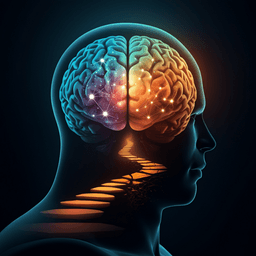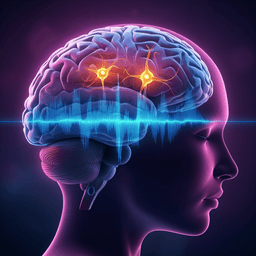
Psychology
Time-dependent consolidation mechanisms of durable memory in spaced learning
Y. Yang, Z. Huang, et al.
Spaced learning, compared to massed learning, boosts cortical integration and replay—especially in default mode network subsystems—and these signatures predict 1‑month durable memory. This research was conducted by Yifeixue Yang, Ziyi Huang, Yun Yang, Mingxia Fan, and Dazhi Yin.
~3 min • Beginner • English
Introduction
Spaced learning, a robust phenomenon in learning and memory, typically yields superior retention and longer-lasting memory than massed learning. Prior neuroimaging work has largely relied on trial-based spacing and focused on encoding mechanisms, showing stronger activation and enhanced item-specific similarity with spacing, but has not fully addressed time-dependent consolidation processes that are more prominent in multi-day (day-based) spaced learning. Behavioral studies suggest that day-based spacing can support memory that endures for months, yet neuroimaging studies often measure retention only over short delays and do not directly test consolidation mechanisms driving durable memory in spaced learning. Consolidation theory posits that long-term memory traces are stabilized via integration and hippocampal-to-cortical transfer over time. Time-dependent consolidation may transform detailed memories into more gist-like, integrated representations and shift dependence from hippocampus to distributed cortical networks via hippocampal–cortical interactions. The DMN, subdivided into dorsal-medial (DMNdm), core (DMNcore), and medial-temporal (DMNmt) subsystems, has been implicated in episodic memory, replay, and integration and may serve as a cortical hub supporting consolidation. However, it remains unclear which neural representations within hippocampus and DMN subsystems contribute to durable memory after spaced learning and whether they predict long-term retention. This study used a between-subject, day-based design with multiple delays (immediate, 1-week, 1-month) to test whether extended consolidation time in spaced learning enhances neural pattern similarity, spontaneous replay, and hippocampal–cortical transfer, and whether these neural signatures predict durable memory (especially in DMNdm), even if immediate test performance is comparable across groups.
Literature Review
The consolidation framework argues that long-term memory formation involves stabilization and transformation of traces, including integration of related memories and a shift from hippocampal dependence toward cortical networks. fMRI work shows increased retrieval-related pattern similarity (neural integration) after delays of a day or a week. Studies also implicate awake replay and increased hippocampal–cortical functional connectivity during post-encoding rest in subsequent memory, with replay prioritization varying by memory strength and time since learning. The DMN has been proposed as a key hub for replay cascades and episodic memory processing, with DMNdm linked to integration/storage, DMNcore as a functional hub, and DMNmt closely tied to hippocampus for encoding/retrieval. Prior multi-day spacing studies often examined short delays, leaving open how time-dependent consolidation manifests in DMN subsystems vs hippocampus in spaced learning and which signatures predict durable memory over longer delays.
Methodology
Design and participants: Between-subject, day-based spacing design. Sixty-nine right-handed adults (38 females; mean age 22.49 ± 1.96 years) from East China Normal University were randomized to 3-day spaced learning (SL; two blocks/day; n=35) or 1-day massed learning (ML; six blocks/day; n=34). Behavioral analyses included all 69. Functional imaging analyses included 48 participants after exclusions for head motion and insufficient trials (SL n=23; ML n=25). Ethics approval and informed consent were obtained.
Materials and task: Sixty picture–word pairs (neutral scenes/objects from GAPED; adjectives from the MRC database translated to 3-character Chinese words) were studied over six total repetitions (blocks) for both groups. Encoding (out of scanner): each picture–word pair presented for 5 s; participants formed associations and rated success (1–5) within 4.5 s. Testing (in scanner): three sessions—immediate, 1-week, and 1-month post-learning. Each test included 60 learned and 30 novel words. Retrieval response within 4 s: 1=learned-object, 2=learned-scene, 3=learned-uncertain, 4=novel; jittered ITI 2–10 s with fixation. Resting-state fMRI was acquired at baseline (pre-learning) and before each test; task fMRI during tests.
Behavioral metrics: d-prime computed from strict hits (correct item plus picture-type) and false alarms; uncertain trials excluded. Retention operationalizations: durable memories defined as those correctly retrieved in both immediate and delayed test (primarily 1-month; also examined 1-week). Retention rate = proportion of durable among immediate-test correct items.
MRI acquisition: 3T Siemens scanner, 20-channel head coil. T1 MPRAGE: 1 mm isotropic. Task fMRI: EPI, TR=2000 ms, TE=30 ms, 33 slices, 3.5 mm thickness, 0.7 mm gap, voxel 3.5 mm isotropic, 15 min per session (450 volumes). Rest fMRI: 8 min (240 volumes).
Preprocessing: Task fMRI with SPM12: slice timing, motion correction, normalization to MNI space, 3 mm iso resampling; no smoothing for multivoxel analyses; high-pass filter 1/128 Hz; motion regressors in GLM. Rest fMRI with DPABI: discard first 10 volumes, motion/CSF/WM nuisance regression, linear detrend, band-pass 0.01–0.08 Hz; normalization analogous to task.
ROIs: Bilateral hippocampus (AAL atlas) and DMN subsystems (DMNdm, DMNcore, DMNmt) from Yeo 17-network parcellation.
Representational similarity analyses (RSA): Trial-wise GLMs yielded beta images per retrieval trial. Intertrial similarity: average pairwise Pearson correlations among beta patterns of successfully retrieved items within each ROI for the immediate test (Fisher z). Temporal similarity for durable items: average pattern correlations for the same item across tests (immediate, 1-week, 1-month) within ROIs.
Replay analysis: For each ROI, GLMs estimated retrieval-evoked multivoxel templates for durable and weak memories (incorrect and novel modeled as covariates). Framewise rest activity patterns were correlated with each template to obtain a 230-TR correlation vector (Fisher z). A threshold at the 90th percentile of the pooled correlation distribution (also validated at 88th, 92nd percentiles and 1.5 SD) defined replay events. Replay increment = post-encoding rest minus baseline rest counts. Analyses conducted for durable and weak templates.
Functional connectivity (FC): Multivoxel resting-state FC between hippocampus and each DMN subsystem computed as mean of Fisher-z-transformed pairwise voxel-to-voxel correlations (m×n connectivity matrix). Changes in FC quantified as immediate post-learning minus baseline. Univariate ROI-mean time course FC also computed for validation.
Searchlight MVPA: Whole-brain searchlight (radius=3 voxels) with SVM classifier (The Decoding Toolbox) to distinguish durable vs weak memories using trial-wise beta images in immediate test; data split evenly into training/testing within participant; group-level one-sample t-test of accuracy maps; AlphaSim corrected p<0.05. Resultant significant masks were intersected with hippocampus/DMN subsystem masks and used for follow-up RSA, temporal similarity, and replay–retention correlations.
Statistics: Independent-samples t-tests for group comparisons; mixed ANOVA for factors group (SL, ML) × test (immediate, 1-week, 1-month); Spearman rho for correlations with retention; outliers beyond 2.5 SD removed; multiple-comparison handling as noted (Bonferroni/LSD; AlphaSim for MVPA).
Key Findings
Behavioral:
- Immediate test: no SL vs ML difference in d′ (t(67)=0.11, p=0.915).
- Delayed tests: SL > ML d′ at 1-week (t(67)=2.38, p=0.020) and 1-month (t(67)=2.95, p=0.004).
- Retention rate (durable among immediate-correct): SL > ML at 1-week (t(67)=2.87, p=0.006) and 1-month (t(67)=2.06, p=0.043).
Neural pattern similarity (immediate retrieval, RSA):
- Intertrial similarity higher in SL than ML within cortex but not hippocampus: DMNdm t(43)=2.05, p=0.046; DMNcore t(43)=2.30, p=0.027; DMNmt t(44)=2.33, p=0.024; hippocampus t(42)=0.50, p=0.617.
- Prediction of 1-month retention rate (SL only): DMNdm rho=0.434, p=0.044; DMNmt rho=0.448, p=0.032; no significant correlations in ML; between-group differences in rho not significant.
- Over time (exploratory mixed ANOVA): main effects of group in DMNcore (F(1,43)=4.54, p=0.039, ηp²=0.10) and DMNmt (F(1,44)=5.45, p=0.024, ηp²=0.11); main effects of test across ROIs; no group×test interactions. Intertrial similarity generally decreased from immediate to delayed tests.
Temporal similarity (durable items):
- No overall mean between-group difference; higher SL than ML between immediate and 1-week in DMNcore (t(46)=2.10, p=0.041) and DMNmt (t(46)=2.08, p=0.044).
- Retention prediction (SL): DMNdm mean across tests rho=0.46, p=0.027; immediate–1-week DMNdm rho=0.47, p=0.023; group differences in correlations not significant.
Replay (rest):
- Durable memories: replay increment >0 after SL in DMNdm (t(22)=2.81, p=0.010) and hippocampus (t(21)=2.54, p=0.019); after ML only in hippocampus (t(24)=2.69, p=0.013). Between-group: DMNdm replay increment higher in SL vs ML (t(46)=2.10, p=0.041).
- Weak memories: replay increment >0 only in hippocampus after ML (t(24)=2.95, p=0.007). No significant cortical replay for weak memories.
Hippocampus–DMN functional connectivity (rest):
- Immediate post-learning multivoxel FC: HIP–DMNdm lower in SL than ML (t(46)=2.05, p=0.046). ΔFC (immediate–baseline) vs retention showed marginal correlation in SL (rho=−0.37, p=0.084). Univariate FC corroborated HIP–DMNdm lower in SL (t(46)=2.11, p=0.040) and ΔFC vs retention significant in ML (rho=0.45, p=0.023).
Searchlight MVPA and follow-ups:
- Regions distinguishing durable vs weak: predominantly DMNdm and anterior DMNcore in SL; hippocampus, DMNmt, and posterior DMNcore in ML, indicating hippocampus–cortex dissociation across learning schedules.
- Within SL MVPA-derived masks: intertrial similarity rho=0.46, p=0.027; temporal similarity rho=0.44, p=0.036; replay number rho=0.44, p=0.038 with retention. Group differences in correlations significant for intertrial similarity (z=1.95, p=0.025) and replay (z=1.65, p=0.050).
Controls/validation:
- Greater intertrial similarity in SL also observed for incorrect trials across DMN subsystems; object > scene main effect in DMNdm; no group×picture-type interactions. Replay findings robust across percentile thresholds (88th, 90th, 92nd) and weaker but consistent at 1.5 SD threshold. Analyses using a 1-week durable definition yielded weaker prediction effects than 1-month, supporting the longer-delay definition for durable memory.
Discussion
The study demonstrates that in multi-day spaced learning, extended consolidation time before the first test does not boost immediate behavioral performance but yields cortical neural signatures that are predictive of long-term retention. Spaced learning increased retrieval-related neural integration in DMN subsystems and selectively enhanced spontaneous replay for durable memories in DMNdm, while hippocampal replay occurred for both learning schedules and even for weak memories under massed learning. These findings align with consolidation theories positing the transformation of memory representations from detailed to integrated, gist-like forms and a gradual shift from hippocampal dependence to cortical storage. The temporal similarity and elevated intertrial similarity within DMNdm, together with reduced hippocampus–DMNdm resting FC after spaced learning, suggest that durable memories are more strongly represented and possibly more stably stored within cortical networks following spaced practice. The dissociation revealed by MVPA—cortical regions (DMNdm/anterior DMNcore) supporting durable memory discrimination in spaced learning versus hippocampus/DMNmt/posterior DMNcore in massed learning—further underscores the distinct systems-level organization underlying durable versus weak memory across learning schedules. Collectively, the results indicate that time-dependent consolidation in spaced learning preferentially promotes cortical integration and replay, which in turn predicts and supports durable memory over longer delays.
Conclusion
Spaced learning induced higher neural pattern similarity in DMN subsystems during immediate retrieval, and intertrial similarity within DMNdm and DMNmt predicted 1-month durable memory. Spaced learning also increased spontaneous replay for durable memories in DMNdm (with hippocampal replay observed for both schedules), and reduced hippocampus–DMNdm functional connectivity, consistent with greater cortical involvement in memory stabilization. These convergent findings suggest that time-dependent consolidation supports neural integration and cortical replay—particularly within DMNdm—underpinning durable memory after spaced learning. Future work should probe consolidation during sleep with EEG/sEEG, include fMRI during encoding, increase item sets with independent testing to minimize retest effects, better control information load at immediate testing, and test longer retention intervals to refine the operational definition of durable memory.
Limitations
- Sleep-related consolidation was not directly measured; EEG/sEEG recordings could clarify sleep mechanisms.
- Encoding-phase neural activity was not collected (multi-day design prioritized retrieval and rest), limiting inference about encoding contributions; between-group differences in incorrect-trial similarity may reflect encoding differences.
- Repeated testing of the same pairs across sessions may influence durability and systems consolidation.
- Different information load on the immediate test day between groups could affect neural activity despite similar immediate performance.
- Potential confounds related to DMN engagement (e.g., boredom/fatigue) cannot be fully excluded.
- The 1-month criterion for durable memory, while stronger than 1-week, may not be optimal; much longer delays are needed to establish best definitions.
Related Publications
Explore these studies to deepen your understanding of the subject.







